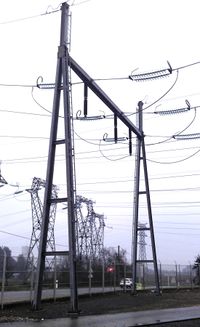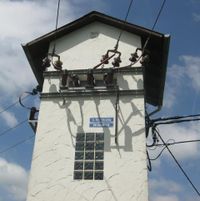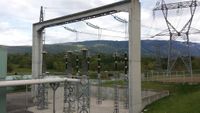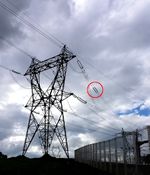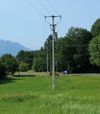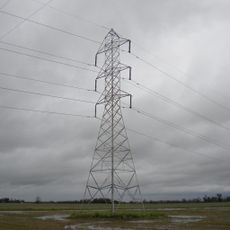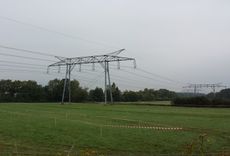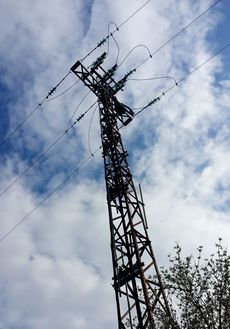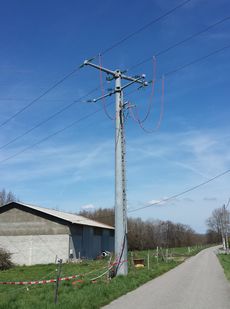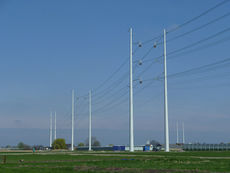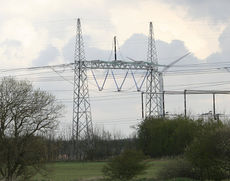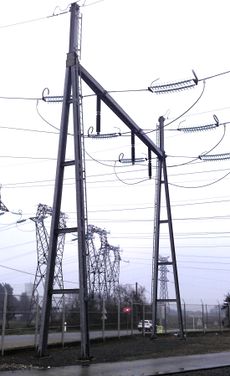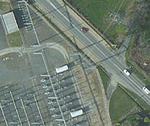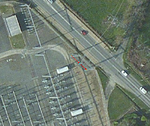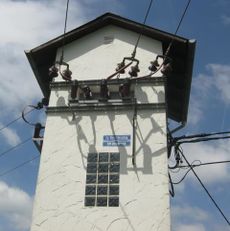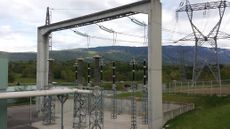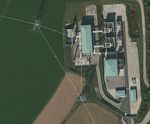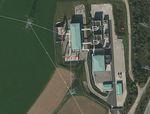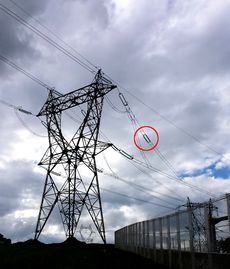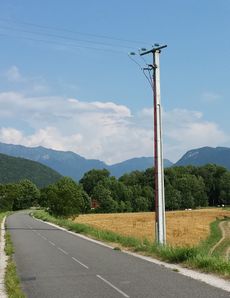Proposal:Power supports refinement
| Power supports refinement | |
|---|---|
| Proposal status: | Rejected (inactive) |
| Proposed by: | Fanfouer |
| Tagging: | power=[[Tag:power=> power=tower, power=pole, power=portal, power=terminal, power=insulator|> power=tower, power=pole, power=portal, power=terminal, power=insulator]] |
| Statistics: |
|
| Rendered as: | power=tower and power=pole |
| Draft started: | 2015-01-30 |
| RFC start: | 2015-01-30 |
| Vote start: | 2015-05-14 |
| Vote end: | 2015-05-29 |
Proposal
This proposal aims to clarify the current usage of the power=tower or power=pole keys. The voltage carried by these supports shouldn't be the difference we make any more.
power=portal, power=terminal and power=insulator and had been introduced to map new kind of power supports according to what mappers can see in reality.
Proposal content is a part of Proposed_features/Power_transmission_refinement which became too large to be voted as such. Knowledge about power networks can be difficult to handle. It is recommended to look at examples to better understand what is proposed.
Rationale
Definitions
Wikipedia and IEC define power transmission infrastructures in these terms:
- A power line (601-03-03, also referred as an electric line) is an arrangement of cables for transferring electricity between sources and loads. A power line may be consists in multiple circuits.
- A power tower (466-08-01) is a support which may be made of such material as steel, wood, concrete, and comprising a body which is normally four-sided, and cross-arms.
- A power pole (466-07-01) is a vertical single member support in wood, concrete, steel or other material, with one end buried in the ground.
- A power insulator (151-15-39) is a device designed to insulate power lines from grounded elements and support it also.
- A Power portal (466-07-02) is composed of two vertical poles linked by a horizontal crossarm near the top.
- A Power terminal (466-06-06) is a support designed to terminate a power line on one side only.
- Power transmission (601-01-09) is bulk transfer of energy from power plants to consumption places.
- Power distribution (601-01-10) is the transfer of energy to consumers inside a consumption place.
OSM usages
The best way to use them in OSM is to keep these simple definitions and build a consistent tagging model.
It's not what is currently done, especially for towers and poles which are currently described according to the voltage they carry.
- power=tower is for "high voltage" lines.
- power=pole is for "low voltage" lines.
- power=portal, power=terminal and power=insulator and are not as many used as both tower or pole.
New approaches
Some enhancement are needed to set-up a consistent power model according to the reality.
This proposal remains focused on the supports of the transmission lines operated at any voltage or even decommissioned.
- Update power=tower and power=pole to encourage using them according to the structure of the feature itself instead of the designed voltage they carry.
- Introduce power=portal key on the grid as sometimes features described as towers look like more to a portal. This key will be useful inside substations too.
- Introduce power=terminal key to link power lines to buildings or fixed infrastructure with a dedicated key.
- Introduce power=insulator as a generic power support to map points of suspension/termination between lines and uncommon supports or
 portals (mapped as a way) for instance.
portals (mapped as a way) for instance. - Replace tower:type=* by support:function=* as for spreading the values to the 5 type of power supports at the same time without introducing 3 more *type keys.
- Replace (actually before it was documented on wiki) tower=air_to_ground since this is also intended by the transition substation type. For more info, see Proposed_features/Substation_refinement#Substation and tower=location_transition or pole=location_transition.
All those modifications would imply a little adaptation work for data consumers. We aim to be compliant with what mappers will see in reality and IEC definitions here. If users wouldn't like to change their processes, they can use a current export of planet.osm. Nevertheless, re-tagging wouldn't be done until a long time.
Basic mapping
Power lines are often supported by power towers or power poles, depending of the environment, the mechanical load and the distance along it is supposed to be carried.
It's actually possible for basic mappers to map about 80% of power grids supports by only using towers or poles.
Most advanced mappers can go further and get in touch with substation or circuits mapping. Here they are some advice to map tower or poles, more detailed tagging is delivered below.
- Towers or poles only exists as nodes in OSM. Put a
 at the intersection of the tower and its shadow on aerial images.
at the intersection of the tower and its shadow on aerial images. - Tag it with power=tower or power=pole depending on its structure : a pole only has one foot in the ground whereas the tower has more - often 4 feet. See the examples section if you want more information.
- You can give information about it's structure with structure=* and design=*. Is it built as metallic lattice (structure=lattice + material=metal) or wood (structure=* + material=wood)?
- If you know which company is in charge of its maintenance, use operator=* to document it and ref=* for its reference number visible sometimes on the feature itself.
- Finally, use colour=* to give the feature colours, separated with ;
If, and only if, you want to give many more details, this proposal goes deeper in the power architecture and gives more tags you can use to map 3 extra supports : portals, terminals and insulators.
Tagging
We should take care of existing features, reuse them as often as we can but this proposal aims to refine model and will force us to re-tag some of these features as described.
Support infrastructure
Referring to IEC definitions quoted above, a tower is a support that is normally four-sided and crossarm built in wood or metal instead of a pole which is a single vertical element built in concrete or often in wood.
Such tags indicate structure of element and NOT its usage on a particular line (mainly depending on voltage).
All supports should be used as described, regardless of voltage or any other rendering problem according to what ![]() RM87 (on osm, edits, contrib, heatmap, chngset com.) explained on talk.
RM87 (on osm, edits, contrib, heatmap, chngset com.) explained on talk.
 power=tower
power=tower
A tower is the most encountered support for power transmission lines. Often composed of a four-sided metal lattice (4 legs linked by metal beams) supporting crossarm on its top.
| Tag | Value | Description | Recommendation |
|---|---|---|---|
| power | tower | It's a power tower | mandatory |
| tower | * | Extra details about the tower usage. | optional |
| support:function | * | Information about the function of the tower | optional |
| ref | Tower reference | Power tower reference as seen in situation | recommended |
| height | height | The height of the tower | optional |
| operator | operator | The power tower operator's name. | recommended |
| structure | lattice, tubular or solid | The structure pattern of the tower | optional |
| design | tower design | The generic design name of the tower without any designer internal reference. | optional |
| design:ref | tower design reference | The design reference of the tower. Most of the time operator's internal references. See F44 for example in France. | optional |
| material | material | The material which the tower is made of. | optional |
| colour | tower colour | The colours of the tower, separated with a ; . | optional |
![]() tower=*
tower=*
| Value | Description |
|---|---|
| location_transition | The tower itself is a location transition (e.g. from aerial to underground) without fence around it (if fence, see substation=transition) |
 power=pole
power=pole
Power poles are masts supporting the power transmission lines. They are different from towers because of the only one leg they have in the ground.
| Tag | Value | Description | Recommendation |
|---|---|---|---|
| power | pole | It's a power pole. | mandatory |
| pole | * | Extra details about the pole usage | optional |
| support:function | * | Information about the function of the pole | optional |
| ref | Pole ref | Power pole reference as seen in situation | optional |
| height | height | The height of the pole | optional |
| operator | operator | The power pole operator's name. | recommended |
| structure | tubular or solid | The structure pattern of the pole. A pole normally can't have a lattice structure until it's a actually a tower. | optional |
| design | pole design | The generic design name of the pole without any internal designer reference. | optional |
| design:ref | pole design reference | The design reference of the pole. Most of the time operator's internal references. See F44 for example in France. | optional |
| material | material | The material which the pole is made of | optional |
| colour | tower colour | The colours of the pole, separated with a ; . | optional |
![]() pole=*
pole=*
| Value | Description |
|---|---|
| location_transition | The pole itself is a location transition (e.g. from aerial to underground) without fence around it (if fence, see substation=transition) |

 power=portal
power=portal
Portals are another sort of power supports. According to the tower or pole definition, portals are different and should be tagged as such.
A portal is a support composed of 2 or more vertical legs linked by horizontal crossarm supporting the cables. Cables are supported inside the legs. If some cables are outside them, it's a h-frame tower and power=tower + design=h-frame must be used.
Portals can be supported by more than 2 legs. It is possible to map them as ![]() when necessarily and relevant.
when necessarily and relevant.
| Tag | Value | Description | Recommendation |
|---|---|---|---|
| power | portal | It's a power portal | mandatory |
| portal | * | Extra details about the portal usage | optional |
| support:function | * | Information about the function of the pole | optional |
| ref | Portal reference | Power portal reference as seen in situation | optional |
| height | height | The height of the portal from the ground | optional |
| operator | operator | The power portal operator's name. | recommended |
| structure | lattice, tubular or solid | The structure pattern of the portal | optional |
| design | portal design | The generic design name of the portal without any designer internal reference | optional |
| design:ref | portal design reference | The design reference of the portal. Most of the time operator's internal references. See F44 for example in France. | optional |
| material | material | The material which the portal is made of. | optional |
| colour | portal colour | The colours of the protal, separated with a ; . | optional |
![]()
![]() portal=*
portal=*
| Value | Description |
|---|---|
| location_transition | The portal itself is a location transition (e.g. from aerial to underground) without fence around it (if fence, see substation=transition) |

 power=terminal
power=terminal
Terminals are useful to link overhead power lines to buildings according to the picture.
They often can be encountered when connecting an overhead line to an indoor substation
It is proposed to map terminals with nodes and tag them as follow :
| Tag | Value | Description | Recommendation |
|---|---|---|---|
| power | terminal | It's a power terminal linking an overhead line to another infrastructure | mandatory |
| support:function | * | It's a power terminal supporting the power line and it's possible to give its precise role. | recommended |
| terminal | * | Extra details about the terminal usage | optional |
| ref | Terminal reference | Power terminal reference as seen in situation | optional |
| height | height | The height of the terminal from the ground | optional |
| operator | operator | The power terminal operator's name. | recommended |
![]()
![]() terminal=*
terminal=*
| Value | Description |
|---|---|
| location_transition | Such terminals are often a location transition (e.g. from aerial to underground) described with terminal=location_transition without fence around it (if fence, see substation=transition). |

 power=insulator
power=insulator
Insulators are devices which protect the line from grounding when connecting (suspension or anchorage) it to a building or a portal.
We also can find them hanging between two towers.
When acting as a support, power insulators can be tagged with power=insulator + support:function=*. The second tag is highly recommended to make the distinguish with standalone hanging insulators. Here is a non-exhaustive list of corresponding situations :
- Portals : On large portals, it can be useful to use insulators to map the link between the power lines and the
 corresponding to the portal. It's mandatory to do so as for distinguishing suspension vs anchor on several lines linked to the same portal.
corresponding to the portal. It's mandatory to do so as for distinguishing suspension vs anchor on several lines linked to the same portal. - Any man made structure : As mentioned on Talk with the Cologne Bridge example, insulators may be useful to link power lines to uncommon supports, like bridges arms.
It is proposed to map insulators with nodes or ways depending on their size or length and tag them as follow :
| Tag | Value | Description | Recommendation |
|---|---|---|---|
| power | insulator | It's a power insulator linking an overhead line to another (grounded) infrastructure | mandatory |
| support:function | * | It's a power insulator supporting the power line and it's possible to give its precise role. | recommended |
| insulator | * | Extra details about the insulator usage | optional |
| ref | Insulator reference | Power insulator reference as seen in situation | optional |
| height | height | The height of the insulator from the ground | optional |
| operator | operator | The power insulator operator's name. | recommended |
| Value | Description |
|---|---|
| location_transition | The insulator used as a terminal is often a location transition (e.g. from aerial to underground) described with insulator=location_transition) without fence around it (if fence, see substation=transition). |
Using insulator=location_transition on insulators is useful when a ![]() power=portal concern many different power lines in many different ways.
power=portal concern many different power lines in many different ways.
Supports function
All the 4 supports described before may have a special functionality in the power line. Let's introduce support:function=* to give such details
![]() support:function=*
support:function=*
| Value | Description |
|---|---|
| suspension | A support which carries the conductors vertically using suspension insulators. This is the default type. However it may be useful to tag a suspension support if it is used as an angle support (an anchor support would normally be expected here). |
| anchor | A support where conductor sections terminate at straight insulators. It is normally built stronger than suspension supports. Mostly used as angle support when the line changes direction. |
| transposing | A support in which the conductors exchange positions in order to balance their capacitance and impedance. |
| crossing | A special support used at river crossings etc where a very long span or a large clearance is required. These supports may be very tall and are therefore significant landmarks. |
| line_termination | The support is ending a power line. |
Please note that tower:type=branch doesn't appear here since it's first of all anchorage on a tower. The "branch" character will be represented by several ways sharing the same node.
Location transition
Location transitions are very useful when power lines goes aerial and connect to underground or undersea cables.
Such transitions now often occurs with urban and suburbs development but with two main different types.
Fenced transition facilities
Adjacent substation proposal is dealing with it by introducing a dedicated type of transition substation : power=substation + substation=transition.
It represents the fenced area which surrounds the transition facility. Transition characteristics may be written with some other tags, please see the proposal for more information.
Concerning power lines, putting power=pole, power=tower, power=insulator or power=portal, typically located in the middle of such transition substation, in common of both underground line and aerial line is enough.
Non fenced facilities
Sometimes, transitions between air and underground or undersea are lighter than a fenced substation. We can use tower=power_transition and pole=power_transition as below:
| Transition place | Tag | Description |
|---|---|---|
| On a power tower | tower=location_transition | When transition is built on a power tower. |
| On a power pole | pole=location_transition | When transition is built on a power pole, typically on low voltage networks. |
| On a power insulator | insulator=location_transition | When insulator allows to change of location, typically on low voltage networks. |
| On a power portal | portal=location_transition | When transition is built on a power portal, typically on low voltage networks. |
Features hosted on poles/towers
Sometimes, features like transformers or switches could be hosted at top of poles or towers. This is often observed on local distribution lines.
Transformer
Use transformer=yes or transformer=distribution to host a transformer on a power support.
References of both pole and transformer may be distinguished with ref:pole=* and ref:transformer=*.
Switch
Use switch=yes to host a power switch on a power support.
References of both pole and switch may be distinguished with ref:pole=* and ref:switch=*.
Connections
Use connection=yes to signify there is a connection between power lines sharing the same power support.
It is assumed it won't be possible to distinguish two different connections on the same support but this will be solved with power routing.
Terminations
Sometimes, sections of power lines can only be a stub where power can't go anywhere.
On any support type, support:function=line_termination should be used.
Values to be replaced
All other values of power=* should be replaced as below:
| Obsolete tag | Used for ? | New tag(s) to use |
|---|---|---|
| power=tower | A pole on a high voltage line | power=pole at any voltage, it's a pole. |
| power=pole | A tower on a low voltage line | power=tower at any voltage, it's a tower. |
| power=anchor | Former value of this proposal used to map actual terminals. | power=terminal. |
| tower=air_to_ground | A transition between aerial and underground | tower=location_transition |
| tower:type=* | Function of the power tower | support:function=* |
| pole:type=* | Function of the power pole | support:function=* |
| tower:type=termination | A tower terminating a power line | support:function=line_termination |
| pole:type=termination | A pole terminating a power line | support:function=line_termination |
| tower:type=tower | Redundant pointless value | no replacement |
| tower:type=branch | A branch tower is first of all an anchorage tower | support:function=anchor |
This table is a guideline for replacement only. Take it with caution and don't do mass edit.
Examples
Let's try to expose current projects, maybe under construction, and legacy ones to give useful case studies to mappers.
Towers
| Case in picture | Location | Comments | Tags |
|---|---|---|---|
| USA | American metallic power tower supporting a high voltage power line operated by PG&E | ||
| France | A h-frame power tower supporting a 400 kV power line in France (cables aren't all between legs) | ||
| France | French tower supporting 20 kV distribution line operated by ERDF | ||
| Germany | A crossing tower beside a large river in Germany |
Poles
| Case in picture | Location | Comments | Tags |
|---|---|---|---|
| France | The most common power pole encountered in France and supporting 20 kV distribution lines. | ||
| Location unknown | Low voltage overhead power lines all along road supported by poles. | ||
| The Netherlands | Two poles supporting each a high voltage circuit. Tags should be applied on each pole. |
Portals
| Case in picture | Location | Comments | Tags |
|---|---|---|---|
| Denmark | A power portal outside a substation | ||
| France | A power portal in an outside power substation and carrying a 225 kV bay line. Mapped as a |
||
| A power portal in an outside power substation and carrying a 225 kV bay line. Mapped as a |
For the portal :
|
Terminals
| Case in picture | Location | Comments | Tags |
|---|---|---|---|
| Germany | Lines connecting to a building in Germany. This situation is common on power distribution networks |
Insulators
| Case in picture | Location | Comments | Tags |
|---|---|---|---|
| France | It's actually possible to represent the portal as a simple |
||
| Or if you prefer to be more precise, you can map the portal as a |
For the concrete portal :
| ||
| France | The hanging insulators behind the metalic tower can be mapped with a |
Transitions
Any kind of location transition on power networks.
| Case in picture | Location | Comments | Tags |
|---|---|---|---|
| France | A transition from air to ground on a concrete power pole operated by ERDF | ||
| Germany | A transition from air to ground on a lattice power tower | ||
| France | A transition from air to gas insulated bay line on a concrete power portal. The picture show a situation inside a transmission substation and should be tagged like a location transition even in a fenced area, because there is many other stuff than this particular transition. |
Features/Pages affected
Reference pages
- power=* : Update the page and features list.
- power=tower : Update the page
- power=pole : Update the page
- power=portal : Create the page
- power=terminal : Create the page
- power=insulator : Create the page
- tower:type=* : Update and indicate this key is replaced by support:function=* for power context only. All other values are preserved.
- tower=location_transition : Add to power=tower page.
- pole=location_transition : Add to power=pole page.
- portal=location_transition : Add to power=portal page.
- terminal=location_transition : Add to power=terminal page.
- insulator=location_transition : Add to power=insulator page.
- support:function=* : Create the page with the 5 values proposed here.
Rendering and Tools/Renderers affected
- power=pole should be rendered with a big plain grey dot instead of power=tower which can be rendered the same as now.
 power=portal should be rendered with an orthogonal pipe on the line.
power=portal should be rendered with an orthogonal pipe on the line.  power=portal should appear with light solid line punctuated with dots for portal poles.
power=portal should appear with light solid line punctuated with dots for portal poles.- power=terminal should be rendered with a half plain grey dot.
- power=isolator should not appear on standard view.
Tools
- JOSM : Update presets to add the new supports (post approval ticket creation)
- ID : Idem
Render
- Update mapnik / mapCSS definitions to show power lines as described above.
- Update at least the following other stylesheets similarly: openstreetbrowser.org, freietonne.de, 4umaps.eu, hikebikemap.de, openstreetmap.de "OSM deustscher stil" style, Reit- und Wanderkarte, latlon.org, osmorg.crite.net, openorienteeringmap "Pseud-O" style, their own style at lightmap.uni-hd.de, and wikimedia toolserver(?) "black and white osm".
Comments
Please post in the discussion page for any comments.
Voting
Vote is open, you can put your feedback with {{vote|yes}} or {{vote|no}}
 I have comments but abstain from voting on this proposal. - I am not happy about defining poles by "They are different from towers because of the only one leg they have in the ground.". In using OSM data in making maps typically size of these features is more important, than role in electric grid or structure. Really big structure with a single leg is for me rather power=tower than power=pole (and currently is mapped as power=tower). On the other hand current definition is even worse, just because voltage on lines was reduced it should not move power=tower to power=pole. Abstaining as I have no better proposal. Note also that especially in case of section #Rendering_and_Tools.2FRenderers_affected this vote is not mandating anything, it is suggesting such changes. Mateusz Konieczny (talk) 09:02, 14 May 2015 (UTC)
I have comments but abstain from voting on this proposal. - I am not happy about defining poles by "They are different from towers because of the only one leg they have in the ground.". In using OSM data in making maps typically size of these features is more important, than role in electric grid or structure. Really big structure with a single leg is for me rather power=tower than power=pole (and currently is mapped as power=tower). On the other hand current definition is even worse, just because voltage on lines was reduced it should not move power=tower to power=pole. Abstaining as I have no better proposal. Note also that especially in case of section #Rendering_and_Tools.2FRenderers_affected this vote is not mandating anything, it is suggesting such changes. Mateusz Konieczny (talk) 09:02, 14 May 2015 (UTC)
 I have comments but abstain from voting on this proposal. I abstain because I missed the RFC. - I would vote yes for the clarifiction to power=tower and power=pole alone but this proposal contains lots of other things.The support:function tag is overloaded. Values of suspension and anchor are about the configuration of insulators and the crossing value is about the height of the tower. How would you tag the configuration of insulators in a "crossing" tower like the example tower in Germany? --Peter Mead (talk) 13:39, 14 May 2015 (UTC)
I have comments but abstain from voting on this proposal. I abstain because I missed the RFC. - I would vote yes for the clarifiction to power=tower and power=pole alone but this proposal contains lots of other things.The support:function tag is overloaded. Values of suspension and anchor are about the configuration of insulators and the crossing value is about the height of the tower. How would you tag the configuration of insulators in a "crossing" tower like the example tower in Germany? --Peter Mead (talk) 13:39, 14 May 2015 (UTC)
 I approve this proposal. This is a better system than what we currently have. I applaud anyone who goes to the amount of work this author has to try to improve the map. Too many proposals get shot down because they aren't perfect.
I approve this proposal. This is a better system than what we currently have. I applaud anyone who goes to the amount of work this author has to try to improve the map. Too many proposals get shot down because they aren't perfect.
 I have comments but abstain from voting on this proposal. I agree there should be more discussion beforehand, a few definitions like that of pole could be improved. Still I tend to vote yes to this, it seems to be an improvement and is well documented (maybe even too much, quite long for a proposal). --Dieterdreist (talk) 11:49, 15 May 2015 (UTC)
I have comments but abstain from voting on this proposal. I agree there should be more discussion beforehand, a few definitions like that of pole could be improved. Still I tend to vote yes to this, it seems to be an improvement and is well documented (maybe even too much, quite long for a proposal). --Dieterdreist (talk) 11:49, 15 May 2015 (UTC)
 I approve this proposal. Janko (talk) 13:12, 15 May 2015 (UTC)
I approve this proposal. Janko (talk) 13:12, 15 May 2015 (UTC) I approve this proposal. Fanfouer (talk) 14:01, 15 May 2015 (UTC)
I approve this proposal. Fanfouer (talk) 14:01, 15 May 2015 (UTC) I oppose this proposal. Sorry for not having checked this proposal thoroughly before (I have recently got some "interference" in my real life). I strongly believe that towers and poles should be directly related to the power line type (line or minor_line). Otherwise you get rendering problems for example by using power=tower on a minor_line will render the towers but not the power line at certain zoom levels. Furthermore I get a bit offended by treating the Wintrack towers (the bipole towers in the last of the pole examples) the same as minor poles (these things actually carry quad 380 kV conductors). Furthermore I prefer to keep power=portal reserved for portal structures within a substation but not to be used for portal-like towers in the open landscape (power=portal should really have been included in the substation scheme as it is a substation component). In the past power=portal was exclusively used for substations by the inventors of that tag (some Germans I guess). I strongly prefer to keep the de facto situation even if it is a bit weakly documented. --opani (talk) 20:04, 18 May 2015 (UTC)
I oppose this proposal. Sorry for not having checked this proposal thoroughly before (I have recently got some "interference" in my real life). I strongly believe that towers and poles should be directly related to the power line type (line or minor_line). Otherwise you get rendering problems for example by using power=tower on a minor_line will render the towers but not the power line at certain zoom levels. Furthermore I get a bit offended by treating the Wintrack towers (the bipole towers in the last of the pole examples) the same as minor poles (these things actually carry quad 380 kV conductors). Furthermore I prefer to keep power=portal reserved for portal structures within a substation but not to be used for portal-like towers in the open landscape (power=portal should really have been included in the substation scheme as it is a substation component). In the past power=portal was exclusively used for substations by the inventors of that tag (some Germans I guess). I strongly prefer to keep the de facto situation even if it is a bit weakly documented. --opani (talk) 20:04, 18 May 2015 (UTC) I approve this proposal. --Isithran (talk) 06:00, 21 May 2015 (UTC)
I approve this proposal. --Isithran (talk) 06:00, 21 May 2015 (UTC) I approve this proposal. --zerpou 18:56, 21 May 2015 (UTC)
I approve this proposal. --zerpou 18:56, 21 May 2015 (UTC) I approve this proposal. User:mboeringa 23 May 2015 I vote yes, because I think this proposal has enough merits and is written by a knowledgeable person concerning the subject. However, I think that some minor things could be improved:
I approve this proposal. User:mboeringa 23 May 2015 I vote yes, because I think this proposal has enough merits and is written by a knowledgeable person concerning the subject. However, I think that some minor things could be improved: I approve this proposal. Because this enables the mapper to decide much clearer what tag is the rigth one for either pole or tower because it refers to that what he see in front of him. --klik (talk) 10:19, 26 May 2015 (UTC)
I approve this proposal. Because this enables the mapper to decide much clearer what tag is the rigth one for either pole or tower because it refers to that what he see in front of him. --klik (talk) 10:19, 26 May 2015 (UTC)
User:mboeringa 23 May 2015 writes: I am not to sure about a possible solution for the problem opani posed, with the "portal" issue regarding portal like structures inside and outside substations...
As to the specific Wintrack "pole" problem opani posed: maybe we should simply name the structure like they are called in the Tennet documentation, and keep the "tower" designation instead of "pole". This would circumvent the problem of these pylons being grouped with poles and possibly not being rendered by the Standard carto style at low zoom:
power=tower
structure=wintrack_pylon
instead of:
power=pole
structure=tubular
"Wintrack pylon" is actually how the Wintrack "poles" are being named in the Tennet documentation about them: http://www.tennet.eu/nl/fileadmin/downloads/About_Tennet/Publications/0512078_TEN_Wintrack_brochure_EN_1_tcm43-18932.PDF Actually, the Wintrack pylon are, even in the Netherlands, a rather big exception. Due to the heightened cost, they have primarily been used in those situations where there was concern about the visual impact on the landscape of "normal" lattice towers, as far as I remember.
Here are my other questions:
- 1) Is it necessary to have five different keys that all reference the same tag value?:
- tower=location_transition
- pole=location_transition
- portal=location_transition
- terminal=location_transition
- insulator=location_transition
The "location_transition" seems to be an attribute of the towers, poles, portals, terminals etc. Therefore I would possibly suggest to use:
location_transition=yes
on all of these features instead of making them a subclass in separate keys.
So you would get something like this instead:
power=tower; location_transition=yes
or
power=portal; location_transition=yes
- 2) I am also slightly wondering if "line_termination" shouldn't be an attribute as well? Again maybe simply like:
line_termination=yes
I am not sure about this one, maybe others can comment here.
- 3) Lastly, maybe it would be good to more clearly list some of the valid domain values for keys as you think they are necessary:
E.g. it is not clear to me what valid values can be used for:
- structure: lattice / tubular / ..?
- design: three-level / h-frame / ..?
- material: metal / concrete / wood / ..? -- User:mboeringa 23 May 2015
 I oppose this proposal. No to this change of meaning of much used tags! All our data users think that power=tower is a tower/pole of a major overhead power line while power=pole is a tower/pole of a minor line. Your proposal both confuses mappers and data users. People won't decide what to render at which zoom level. Not every data user wants to render a power grid map. Most map producers want to render a map which helps people to find something. Towers/poles of large power lines are a important landmark while poles/towers of minor lines are a not so important feature. Do you want that maps both at osm.org and those of third parties show some lonely towers because there a few four-legged towers in a line which ususally has one-legged poles? Every data user has to modify his stylesheets and scripts. There will be lot's of cases in future where mappers use the "wrong" tags because they have not noticed your changes.
I oppose this proposal. No to this change of meaning of much used tags! All our data users think that power=tower is a tower/pole of a major overhead power line while power=pole is a tower/pole of a minor line. Your proposal both confuses mappers and data users. People won't decide what to render at which zoom level. Not every data user wants to render a power grid map. Most map producers want to render a map which helps people to find something. Towers/poles of large power lines are a important landmark while poles/towers of minor lines are a not so important feature. Do you want that maps both at osm.org and those of third parties show some lonely towers because there a few four-legged towers in a line which ususally has one-legged poles? Every data user has to modify his stylesheets and scripts. There will be lot's of cases in future where mappers use the "wrong" tags because they have not noticed your changes.
- History (e.g. public transport) shows us that changing the meaning of tags (e.g. route=train) does not really work, only causes confusion among mappers and data consumers and repells mappers (only few people map public transport).
- Changing tags or their meaning usually means that you (or someone else) wants to do a mechanical edit "in order to change that". I won't be surprised if the proposal of that mechanical edit will be declined (at least in Germany).
- If your proposal would not change the meaning of power=pole and power=tower, I would agree. I hereby suggest you to reject this proposal and to create a new proposal which does not change the meaing of power=tower and power=pole. Unfortunately, you seem not to be able to draw lessons from the rejection you got with your large Proposal "Power Transmission Refinement" which was declined because it changed the meaning of broadly used tags. --Nakaner (talk) 17:08, 23 May 2015 (UTC)
 I oppose this proposal. Never ever change so widely used tags. Create new, additional subtags and everything will be fine. (wambacher) 17:46, 23 May 2015 (UTC)
I oppose this proposal. Never ever change so widely used tags. Create new, additional subtags and everything will be fine. (wambacher) 17:46, 23 May 2015 (UTC) I oppose this proposal. Keep it simple, don't change existing meanings --chris66 (talk) 20:59, 23 May 2015 (UTC)
I oppose this proposal. Keep it simple, don't change existing meanings --chris66 (talk) 20:59, 23 May 2015 (UTC) I oppose this proposal. Nakaner's vote's first chapter (above) explains exactly my reasons. The proposed difference between towers and poles does not work well to differentiate between the "huge" and "smaller" supports; for example
I oppose this proposal. Nakaner's vote's first chapter (above) explains exactly my reasons. The proposed difference between towers and poles does not work well to differentiate between the "huge" and "smaller" supports; for example  is a big tower with 100+ kV, but only has a single tubular leg, because the room was needed for a road. More examples at Tag:power=tower/Gallery, although that page doesn't look very easy to read at the moment. Otherwise this looks like a sound proposal. Alv (talk) 18:20, 23 May 2015 (UTC)
is a big tower with 100+ kV, but only has a single tubular leg, because the room was needed for a road. More examples at Tag:power=tower/Gallery, although that page doesn't look very easy to read at the moment. Otherwise this looks like a sound proposal. Alv (talk) 18:20, 23 May 2015 (UTC) I oppose this proposal.--Rza31 (talk) 18:41, 23 May 2015 (UTC)
I oppose this proposal.--Rza31 (talk) 18:41, 23 May 2015 (UTC) I oppose this proposal.--Bekri 12:57, 24 May 2015 (UTC)
I oppose this proposal.--Bekri 12:57, 24 May 2015 (UTC) I have comments but abstain from voting on this proposal.
I have comments but abstain from voting on this proposal.
This proposal is a good idea, but power=pole is used too often. It's a good idea to discuss the support issue first. Single-leg towers on major powerlines should be tagged as power=mast (credit to rogehm) - with a new tag we can start without disputes on traditional tagging. Four-leg towers on minor powerlines should be tagged as power=minor_tower. Unfortunately the tagging discussion happens only during voting procedure. --FK270673 (talk) 11:02, 24 May 2015 (UTC)
 I oppose this proposal. Zimba (talk) 14:17, 24 May 2015 (UTC)
I oppose this proposal. Zimba (talk) 14:17, 24 May 2015 (UTC) I oppose this proposal. Sorry, The proposal is well thought out. I particularly like the solution for the German / Cologne problem (power=insulator).
I oppose this proposal. Sorry, The proposal is well thought out. I particularly like the solution for the German / Cologne problem (power=insulator).
But please, no pole for the following example: 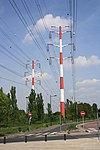 or no tower for this (20kV):
or no tower for this (20kV):  .
It should be given to the tag power=mast introduce. Please, again superior. --RoGer6 (Rogehm) 20:57, 25 May 2015 (UTC)
.
It should be given to the tag power=mast introduce. Please, again superior. --RoGer6 (Rogehm) 20:57, 25 May 2015 (UTC)
 I oppose this proposal. I can not accept that a 220 kV line has to be tagged with power=pole. The Pole information could be in included inside a tower=pole tag.--Oberaffe (talk) 13:37, 26 May 2015 (UTC)
I oppose this proposal. I can not accept that a 220 kV line has to be tagged with power=pole. The Pole information could be in included inside a tower=pole tag.--Oberaffe (talk) 13:37, 26 May 2015 (UTC) I have comments but abstain from voting on this proposal. I've always been a little bit on the fence about the changes regarding power=tower & power=pole and after some rethinking I'm now of the opinion that there should be an easy way (first level tag) to differentiate big structures from small ones, just from the cartographic standpoint. Actually I think that the combination of f.i. structure=tubular, design=barrel & material=steel should be enough to characterise a single pole steel tube tower like that shown by RoGer6 above. So my vote would be yes to the new tags like power=terminal, power=insulator & power=portal, start documentation of those. But no to the changes of power=tower & power=pole. Their current definition probably is by no means perfect, but the proposed changes would make it a lot more messier, at least from my point of view. --TOGA (talk) 14:01, 26 May 2015 (UTC)
I have comments but abstain from voting on this proposal. I've always been a little bit on the fence about the changes regarding power=tower & power=pole and after some rethinking I'm now of the opinion that there should be an easy way (first level tag) to differentiate big structures from small ones, just from the cartographic standpoint. Actually I think that the combination of f.i. structure=tubular, design=barrel & material=steel should be enough to characterise a single pole steel tube tower like that shown by RoGer6 above. So my vote would be yes to the new tags like power=terminal, power=insulator & power=portal, start documentation of those. But no to the changes of power=tower & power=pole. Their current definition probably is by no means perfect, but the proposed changes would make it a lot more messier, at least from my point of view. --TOGA (talk) 14:01, 26 May 2015 (UTC) I oppose this proposal.because I think the disadvantages of the big redefinition of the existing tags pole and tower does not match the advantages. 21:21, 27 May 2015 (UTC)
I oppose this proposal.because I think the disadvantages of the big redefinition of the existing tags pole and tower does not match the advantages. 21:21, 27 May 2015 (UTC) I oppose this proposal. I have the same comments as Chris66 and wambacher --Foxxi59 (talk) 04:33, 28 May 2015 (UTC)
I oppose this proposal. I have the same comments as Chris66 and wambacher --Foxxi59 (talk) 04:33, 28 May 2015 (UTC) I oppose this proposal. Don't exchange the meaning of existing and widely used tags, this would result in a big mess --zarl (talk) 08:07, 28 May 2015 (UTC)
I oppose this proposal. Don't exchange the meaning of existing and widely used tags, this would result in a big mess --zarl (talk) 08:07, 28 May 2015 (UTC) I approve this proposal. The new meaning of pole and tower would be a lot more useful. --Tordanik 12:13, 28 May 2015 (UTC)
I approve this proposal. The new meaning of pole and tower would be a lot more useful. --Tordanik 12:13, 28 May 2015 (UTC) I oppose this proposal. --Saxonyking (talk) 18:26, 28 May 2015 (UTC)
I oppose this proposal. --Saxonyking (talk) 18:26, 28 May 2015 (UTC) I have comments but abstain from voting on this proposal. I would extract everything exept pole/tower portion and split that into small proposals. A short one week rfc time would be sufficient for those small proposals so people can refine these parts if needed and not get carried away with this pole/tower mess. For that part I would give my yes.
I have comments but abstain from voting on this proposal. I would extract everything exept pole/tower portion and split that into small proposals. A short one week rfc time would be sufficient for those small proposals so people can refine these parts if needed and not get carried away with this pole/tower mess. For that part I would give my yes.
- Part with pole/tower is problematic due to semantics. It seems that many have jet to understand the fact that words 'pole' and 'tower' are very ambitious. Different people do see cardinally different things behind those words. The voters comments and posted images do show it well.
- Maybe introducing power=mast, letting go of voltage based categorising and using detailed structure description for all three tags halps. Maybe something more radical is needed.
- At least I hope that this proposal made some more people understand that the current way of tagging is more like tagging for the renderer (to make maps look nice) than to reflect the reality. RM87 22:22, 28 May 2015 (UTC)
Voting is over
Thank you all for the numerous feedbacks you left there. Several of them will help to build better tags.
8 pros against 14 cons (6 abstentions). This proposal is for now rejected. A more complete analysis to all the suggestions made is in progress as for finding kind of consensus arround particular points.
Come back in few days. Fanfouer (talk) 21:51, 29 May 2015 (UTC)

